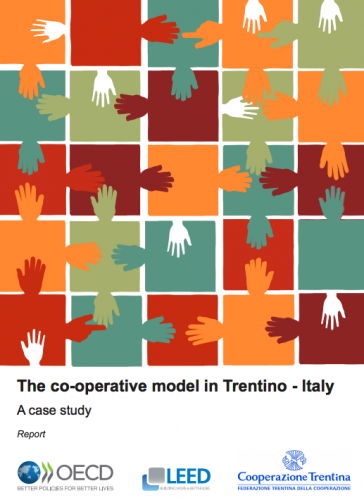The Trentino co-operative model has gained wide acclaim for its positive economic and social impact upon the territory. Developing a strong understanding of why the model has been so effective is important in identifying those factors which other localities could utilise as potential criticalities. This case study has therefore focused on developing an in-depth understanding of the Trentino model of the co-operative movement and its Federation. In particular, it has examined and assessed the various components which have contributed to making the Trentino model highly effective in delivering economic and social benefits for the province of Trento and its residents.
Download the Trentino Case Study
Main issues to be addressed
While examining what has made the Trentino co-operative system (or model) so successful, it is also necessary to understand the wider capacity of the co-operative movement to address social needs and deliver economic impact, as well as the challenges it may confront.
The research aims to develop a deeper understanding of the co-operative movement itself, alongside how it has addressed some of the challenges frequently confronted. Furthermore, it provides a detailed case study that will be of use to an international audience eager to understand what has made the co-operative movement in Trentino so successful.
Accordingly, the study has focused on the role and impact of the co-operative movement within Trentino, its specific structure (including the institutional, policy, legal and fiscal frameworks), its economic contribution (in terms of value, job creation and maintenance, etc.) and its social impact (including the social return on investment).
Method of work
The OECD has formed an expert panel composed of the OECD Secretariat and 3 international senior experts. This panel has undertaken diagnostic work, conducted interviews with relevant local individuals and institutions also during a 3-day study visit in June 2014; and, identified the strengths and weaknesses of the model through comparison with international good practice.
This panel has undertaken a diagnostic work including the review of the existing literature on the evolution of the co-operative movements and the reports of the Trentino Federation of Co-operatives. The panel conducted interviews with relevant local individuals and institutions during a 3-day study visit in June 2014. The strengths and the weaknesses of the model were identified with an interdisciplinary approach according to the areas of expertise, political, economic and organizational. The Trentino model has been compared with international good practices. During the interviews, participants were asked to describe the policies and procedures of their departments, co-operatives or consortia, their ways of working with members, and their perceptions of the benefits and challenges associated with the competitors, the associated co-operatives or the local institutions and communities.
In this regard the expert panel was asked to identify and evaluate the evolution of the co-operative movement in order to:
- Promote local development and benefits for the members with the incentives of the legal and fiscal framework;
- Address the challenges arising from the increased competition with traditional enterprises and the economic recession;
- Discuss good practices and lessons learned by co-operatives in order to identify key elements and factors to successfully scale up the resilience capacity of co-operatives;
- Discuss good practices and lessons learned by other co-operative models in order to identify key elements and factors for innovation;
- Identify and explore options for future directions and activities in areas where the co-operative advantages can be exploited to provide sustainable opportunities.
Download the Trentino Case Study
Table of Contents
| INTRODUCTION | |
| • | Main issues to be addressed |
| • | Method of work |
| HISTORICAL INTRODUCTION | |
| • | Origins and key factors in the European co-operative movement |
| • | The co-operative movement in Trentino, Italy: historical, economic and social contributions to the region |
| • | Some concluding remarks |
| CONTEMPORARY CO-OPERATIVE MOVEMENT | |
| • | The role of the legal and fiscal framework for the development of co-operatives |
| • | The peculiarity of the Autonomous Province of Trento: a determinant factor for the development of the co-op system in Trentino? |
| • | Overview of the major sectors co-operatives operate in within the province: agricultural, credit, consumer, social, etc. |
| • | Outline of sectoral size (turnover, staff, membership, etc) |
| THE GOVERNANCE OF THE TRENTINO CO-OPERATIVE SYSTEM: THE ROLE OF THE TRENTINO FEDERATION OF CO-OPERATIVES | |
| • | A complex governance system: the importance of networks for the co-operative movement |
| • | The role of the Trentino Federation of Co-operatives (FTC) |
| • | The contemporary role of the Federation for/to the co-operative movement |
| RESILIENCE | |
| • | The economic resilience of the co-operative movement |
| CONFRONTING THE TRENTINO CO-OPERATIVE SYSTEM WITH OTHER INTERNATIONAL CO-OPERATIVE SYSTEMS | |
| • | COSTA RICA |
| • | URUGUAY |
| • | QUEBEC |
| • | ANDALUSIA |
| • | VÄSTRA GÖTALAND |
| • | FRANCE |
| ANNEX I: STUDY VISIT INTERVIEWS – 4/5/6 JUNE 2014, TRENTO, ITALY | |
| ANNEX II: INTERNATIONAL REVIEW PANEL | |
| BIBLIOGRAPHY | |





